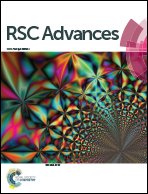Low-temperature catalytic oxidation of CO over highly active mesoporous Pd/CeO2–ZrO2–Al2O3 catalyst†
Abstract
Mesoporous nano Pd/CeO2, Pd/CeO2–ZrO2 and Pd/CeO2–ZrO2–Al2O3 catalysts were prepared via a soft template-assisted hydrothermal method and employed in low-temperature catalytic CO oxidation. Almost 100% of CO conversion could be obtained by the optimal Pd/CeO2–ZrO2–Al2O3 catalyst at 60 °C. Addition of Zr and Al into Pd/CeO2 lead to an increase of the pore volume, average size of mesopores, the surface Ce3+/Ce4+ atomic ratios and Oadsorbed/Olattice, while the activation energy (Ea) decreased in the order Pd/CeO2 (50.4 kJ mol−1) > Pd/CeO2–ZrO2 (40.7 kJ mol−1) > Pd/CeO2–ZrO2–Al2O3 (32.4 kJ mol−1). The low-temperature CO catalytic conversion increased with the decreased activation energy (Ea).


 Please wait while we load your content...
Please wait while we load your content...